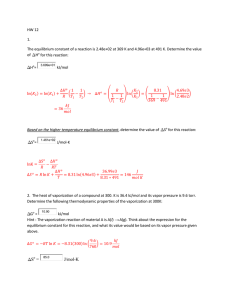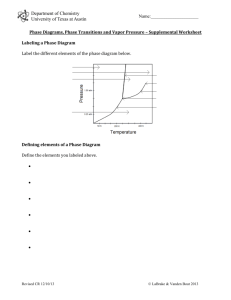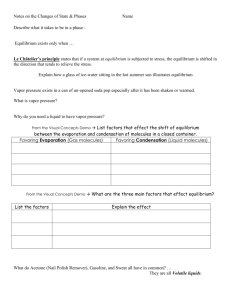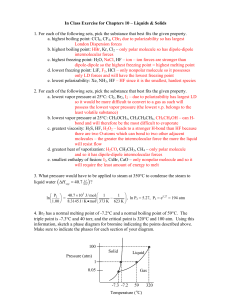Spring Exam 1 - Chemistry
advertisement
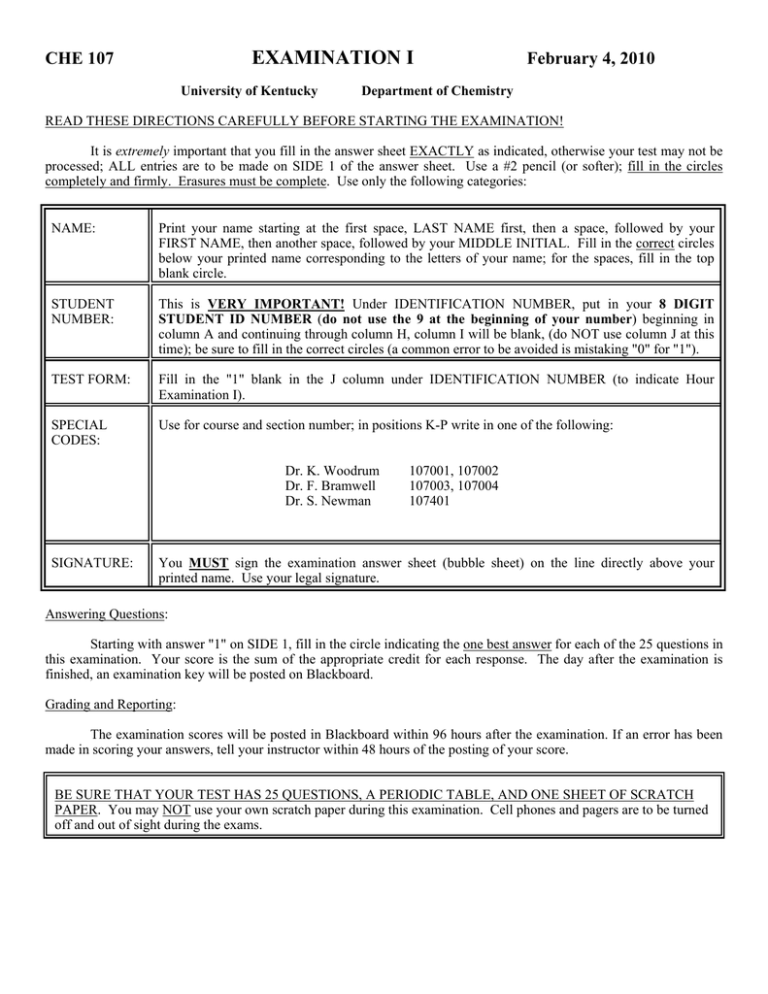
EXAMINATION I CHE 107 University of Kentucky February 4, 2010 Department of Chemistry READ THESE DIRECTIONS CAREFULLY BEFORE STARTING THE EXAMINATION! It is extremely important that you fill in the answer sheet EXACTLY as indicated, otherwise your test may not be processed; ALL entries are to be made on SIDE 1 of the answer sheet. Use a #2 pencil (or softer); fill in the circles completely and firmly. Erasures must be complete. Use only the following categories: NAME: Print your name starting at the first space, LAST NAME first, then a space, followed by your FIRST NAME, then another space, followed by your MIDDLE INITIAL. Fill in the correct circles below your printed name corresponding to the letters of your name; for the spaces, fill in the top blank circle. STUDENT NUMBER: This is VERY IMPORTANT! Under IDENTIFICATION NUMBER, put in your 8 DIGIT STUDENT ID NUMBER (do not use the 9 at the beginning of your number) beginning in column A and continuing through column H, column I will be blank, (do NOT use column J at this time); be sure to fill in the correct circles (a common error to be avoided is mistaking "0" for "1"). TEST FORM: Fill in the "1" blank in the J column under IDENTIFICATION NUMBER (to indicate Hour Examination I). SPECIAL CODES: Use for course and section number; in positions K-P write in one of the following: Dr. K. Woodrum Dr. F. Bramwell Dr. S. Newman SIGNATURE: 107001, 107002 107003, 107004 107401 You MUST sign the examination answer sheet (bubble sheet) on the line directly above your printed name. Use your legal signature. Answering Questions: Starting with answer "1" on SIDE 1, fill in the circle indicating the one best answer for each of the 25 questions in this examination. Your score is the sum of the appropriate credit for each response. The day after the examination is finished, an examination key will be posted on Blackboard. Grading and Reporting: The examination scores will be posted in Blackboard within 96 hours after the examination. If an error has been made in scoring your answers, tell your instructor within 48 hours of the posting of your score. BE SURE THAT YOUR TEST HAS 25 QUESTIONS, A PERIODIC TABLE, AND ONE SHEET OF SCRATCH PAPER. You may NOT use your own scratch paper during this examination. Cell phones and pagers are to be turned off and out of sight during the exams. 1. 2. 3. Which of the following incorrectly fills in the blank for the sentence below? Gases _________________________________ than the condensed states of liquids and gases. A. are much more compressible C. B. have much lower densities D. Which of the following groups of compounds has the normal boiling points arranged in increasing temperature order? A. H2S, H2Se, H2Te, H2O C. SnH4, SiH4, GeH4, CH4 B. HF, HCl, HBr, HI D. NH3, PH3, AsH3, SbH3 Which of these statements correctly describe the reasoning for why ice is less dense than liquid water? A. B. C. D. 4. 5. have much greater distances between molecules have much lower molar masses The intermolecular forces of H2O are too weak to hold the molecules close together. The high viscosity of water doesn’t allow it to flow keeping if from forming a dense solid. The rigidity of the organized structure of water when crystallizing doesn’t allow for tight packing. This is an unexplained phenomenon. Which statement is true concerning the simple cubic unit cell? A. The cell contains eight atoms. C. The cell only contains lattice points on the corners of the cube. B. The coordination number is D. The lattice points are not shared between four. unit cells. Platinum has a cubic crystal structure with an edge length of 392 pm and a density of 21.5 g/cm3. How many platinum atoms are there in a unit cell? A. 1 C. 4 B. 2 D. 6 6. 7. 8. 9. When X rays of wavelength 0.124 nm are diffracted by a metallic crystal, the angle of first order diffraction (n=1) is measured to be 21.3o. What is the distance (in pm) between the layers of atoms responsible for the diffraction? A. 171 pm C. 0.00585 pm B. 341 pm D. 0.182 pm An allotrope of boron has the formula B12. It has a melting point of 2300oC. Classify this crystalline solid. A. Ionic solid C. Molecular solid B. Covalent solid D. Metallic solid The crystal structure of the unit cell for CaF2 shown in the figure below has Ca2+ ions occupying the lattice points of a face-centered cube. Each F– ion is tetrahedrally surrounded by four Ca2+ ions. In total, how many Ca2+ ions and F– ions occupy the unit cell? A. 4 C. 6 B. 12 D. 9 Which of these statements is true regarding liquids and their vapor? A. The vapor pressure of a liquid is only dependant on the temperature. B. The vapor of a liquid decreases with lesser intermolecular forces. C. The vapor of the liquid only exists once the temperature is greater than the boiling point. The amount of vapor above a liquid increases until evaporation and condensation reach equilibrium. D. 10. 11. A closed 5.00 L flask contains 3.00 g of mercury. The system is at room temperature of 25 oC. By how many degrees should we increase the temperature of the flask to increase the mercury vapor pressure by a factor of ten? (Hvap for mercury is 59.0 kJ/mol.) A. 32oC C. 94oC B. 45oC D. 120oC Which of the following statements concerning liquid-solid equilibrium is true? A. B. C. D. 12. 13. The addition of heat to a solid substance in equilibrium with its liquid raises the temperature of the liquid but not the solid. The removal of heat from a solid substance in equilibrium with its liquid lowers the temperature of the liquid but not the solid. The addition of heat to a solid substance in equilibrium with its liquid does not change the temperature of the liquid or the solid. The addition of heat to a liquid substance in equilibrium with its solid raises the temperature of the liquid and the solid How much heat (in kJ) is needed to convert 632 g of ice at –14.0°C to steam at 100. °C? The specific heat of ice is 2.03 J/g•°C, water is 4.184 J/g•C, and steam is 1.99 J/g•C. The heat of fusion is 6.01 kJ/mol and the heat of vaporization is 40.79 kJ/mol). A. 2.84 105 kJ C. 475 kJ B. 1.92 103 kJ D. 282 kJ Consider the phase diagram of carbon dioxide below. Which of the following conditions will lead to the melting of solid carbon dioxide? A. B. Below 1.0 atm, solid CO2 can melt. At normal atmospheric pressure, CO2 can melt. C. At 5.2 atm, solid CO2 can melt. D. At 7.5 atm, solid CO2 can melt. 14. 15. 16. 17. At 20 C, a liquid solution contains 25.6 g sodium acetate trihydrate in 100 g water. The composition of a saturated solution of sodium acetate trihydrate at 20 C is 46.5 g sodium acetate trihydrate in 100 g water. The liquid solution is said to be: A. Unsaturated C. Saturated B. Supersaturated D. Hyposaturated Which of these compounds is likely to be soluble in cyclohexane (C6H12) and is correctly listed with the intermolecular forces between solute and solvent? A. KOH, ion – induced dipole C. NH3, hydrogen bonding B. CCl4 , dispersion forces D. CO2, dipole – dipole Calculate the molality of a solution prepared by dissolving 25.0 grams of potassium (KNO3) nitrate in 150.0 grams of water. A. 16.7 m C. 14.3 m B. 1.65 m D. 2.95 m A 2.60 M aqueous solution has a density of 1.40 g/mL. The solute’s molar mass is 245 g/mol. Assume the density of water is 1.00 g/mL. What is the molality of the solution? A. 2.54 m C. 2.60 m B. 5.08 m D. 3.41 m 18. Which of these statements is true of the effects of solute on solution? A. A large bulky glucose molecule (C6H12O6 ) will lower the vapor pressure of water less than the same number of moles of NaCl. B. Because of the connection between vapor pressure and boiling point, both vapor pressure and boiling point increase with the concentration of particles in solution. C. A nonpolar solute raises the freezing point by increasing the intermolecular forces in the solution. D. The vapor pressure of a solution is unaffected by the concentration of a solute. 19. Under which set of conditions will the most oxygen gas dissolve in water? A. B. Low temperature and low pressure of O2. High temperature and low pressure of O2. C. Low temperature and high pressure of O2. D. High temperature and high pressure of O2. 20. 21. 22. 23. 24. 25. What is the concentration of CO2 in a soft drink that is bottled with a partial pressure of CO2 of 4.00 atm over the liquid at 25 C? The Henry’s Law constant for CO2 in water at 25 C is 3.1 10–2 mol/L•atm. A. 0.12 M C. 0.075 M B. 1.33 M D. 0.50 M A sample of antifreeze from your car has 320 g of ethylene glycol (C2H6O2) and 1250 g of H2O. At what temperature will it freeze if the Kf for water is 1.86 C/m? A. 4.76 C C. 108 C B. –4.12 C D. –7.67 C A solution is prepared by dissolving an unknown mass of urea, (NH2)2CO, in enough water to make 100.0 mL of solution. The osmotic pressure of the solution at 25.00 °C is 47.9 atm. How many grams of urea are in the solution? A. 0.112 g C. 1.92 g B. 11.8 g D. 14.9 g The boiling point of pure CS2 is 46.30 oC, and its boiling point elevation constant Kb is 2.34 oC/m. A solution of sulfur in liquid CS2, which was prepared by dissolving 2.26 g S in 50.0 g CS2, boils at 46.71oC. What is the molecular formula of the dissolved S molecules? A. S8 C. S12 B. S4 D. S Which of these solutes would have the largest effect on the boiling point of a solvent, assuming the same number of moles of each solute was added to the quantity of solvent? A. NH2CH2COOH C. KCl B. MgSO4 D. FeBr3 Which of the following is true? A. Colloids have smaller particles suspended in the solvent than solutions. B. Colloids are simply very high concentrated solutions. C. A colloid will scatter a beam of light; whereas, a solution will not. D. Colloids are solutions which have very, very low concentrations. CHE 107 Exam 1 February 4, 2010 Question Corrrect Answer 1 2 3 4 5 6 7 8 9 10 11 12 13 14 15 16 17 18 19 20 21 22 23 24 25 D A C C C A B A D A C B C D A B B D A C A D B A D C
